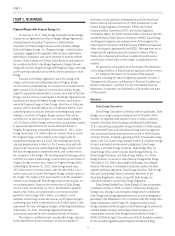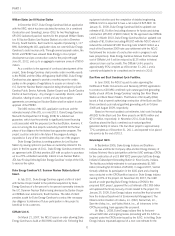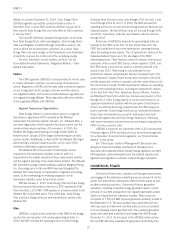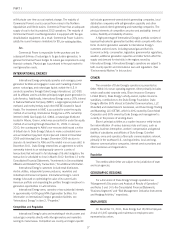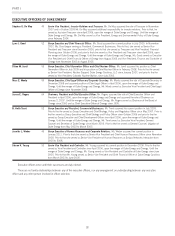Duke Energy 2011 Annual Report Download - page 32
Download and view the complete annual report
Please find page 32 of the 2011 Duke Energy annual report below. You can navigate through the pages in the report by either clicking on the pages listed below, or by using the keyword search tool below to find specific information within the annual report.
PART I
The natural gas procurement strategy is to contract with one or
several suppliers who buy spot market natural gas supplies along
with firm or interruptible interstate pipeline transportation capacity for
deliveries to the sites. This strategy allows for competitive pricing,
flexibility of delivery, and reliable natural gas supplies to each of the
natural gas plants. In addition, Duke Energy Carolinas entered into a
20 year contract for firm capacity to serve a portion of the Buck and
Dan River facilities. Many of the natural gas plants can be served by
several supply zones and multiple pipelines.
Nuclear.
The industrial processes for producing nuclear generating fuel
generally involve the mining and milling of uranium ore to produce
uranium concentrates, the services to convert uranium concentrates
to uranium hexafluoride, the services to enrich the uranium
hexafluoride, and the services to fabricate the enriched uranium
hexafluoride into usable fuel assemblies.
Duke Energy Carolinas has contracted for uranium materials
and services to fuel the Oconee, McGuire and Catawba Nuclear
Stations in the Carolinas. Uranium concentrates, conversion services
and enrichment services are primarily met through a diversified
portfolio of long-term supply contracts. The contracts are diversified
by supplier, country of origin and pricing. Duke Energy Carolinas
staggers its contracting so that its portfolio of long-term contracts
covers the majority of its fuel requirements at Oconee, McGuire and
Catawba in the near-term and decreasing portions of its fuel
requirements over time thereafter. Near-term requirements not met by
long-term supply contracts have been and are expected to be fulfilled
with spot market purchases. Due to the technical complexities of
changing suppliers of fuel fabrication services, Duke Energy Carolinas
generally sources these services to a single domestic supplier on a
plant-by-plant basis using multi-year contracts.
Duke Energy Carolinas has entered into fuel contracts that,
based on its current need projections, cover 100% of the uranium
concentrates, conversion services, and enrichment services
requirements of the Oconee, McGuire and Catawba Nuclear Stations
through at least 2013 and cover fabrication services requirements for
these plants through at least 2018. For subsequent years, a portion
of the fuel requirements at Oconee, McGuire and Catawba are
covered by long-term contracts. For future requirements not already
covered under long-term contracts, Duke Energy Carolinas believes it
will be able to renew contracts as they expire, or enter into similar
contractual arrangements with other suppliers of nuclear fuel
materials and services.
Energy Efficiency.
Several factors have led to increased focus on energy efficiency,
including environmental constraints, increasing costs of generating
plants and legislative mandates regarding building codes and
appliance efficiencies. As a result of these factors, Duke Energy has
developed various programs designed to promote the efficient use of
electricity by its customers. These programs and associated
compensation mechanisms have been filed with various state
commissions over the past several years.
In February 2009, the NCUC approved Duke Energy Carolinas’
energy efficiency programs and authorized Duke Energy Carolinas to
implement its rate rider pending approval of a final compensation
mechanism by the NCUC. Duke Energy Carolinas began offering
energy conservation programs to North Carolina retail customers and
billing a conservation-program only rider on June 1, 2009. In
October 2009, Duke Energy Carolinas also began offering demand
response programs in North Carolina. In December 2009, the NCUC
approved the save-a-watt compensation mechanism and, effective
January 1, 2010, Duke Energy Carolinas began billing a rate rider
reflecting both conservation and demand response programs. Since
that time, additional programs have been filed by Duke Energy
Carolinas and approved by the NCUC for delivery under the
save-a-watt mechanism. The save-a-watt programs and
compensation approach in North Carolina are approved through
December 31, 2013.
Duke Energy Carolinas began offering demand response and
conservation programs to South Carolina retail customers effective
June 1, 2009. In January 2010, the PSCSC approved a save-a-watt
rider for Duke Energy Carolinas’ energy efficiency programs. Duke
Energy Carolinas began billing this rider to retail customers
February 1, 2010. Since that time, additional programs have been
filed by Duke Energy Carolinas and approved by the PSCSC for
delivery under the save-a-watt mechanism. The save-a-watt
programs and compensation approach in South Carolina are
approved through December 31, 2013.
Save-a-watt was approved by the PUCO in December 2008, in
conjunction with the Electric Security Plan (ESP), and Duke Energy
Ohio began offering programs and billing a rate rider effective
January 1, 2009. Save-a-watt was approved in Ohio through
December 31, 2011. A shared-savings compensation mechanism
was filed with the PUCO on July 20, 2011, with a proposed effective
date of January 1, 2012. Approval of Duke Energy Ohio’s shared-
savings mechanism is pending with the PUCO.
On September 28, 2010, Duke Energy Indiana filed a petition
for new energy efficiency programs to enable meeting the IURC’s
energy efficiency mandates. Duke Energy Indiana’s proposal requests
recovery of costs through a rider including lost revenues and
incentives for “core plus” energy efficiency programs and lost
revenues and cost recovery for “core” energy efficiency programs. The
hearing occurred in July 2011 and an order is expected in the first
quarter of 2012.
In January 2010, Duke Energy Kentucky withdrew the
application to implement save-a-watt. Energy efficiency programs
continue under Duke Energy Kentucky’s existing demand-side
management program.
SmartGrid and Distributed Renewable Generation Demonstration
Project.
Duke Energy Indiana filed a petition and case-in-chief
testimony, supporting its request to build an intelligent distribution
grid in Indiana. The proposal requested approval of distribution
formula rates or, in the alternative, a SmartGrid rider to recover the
return on and of the capital costs of the build-out and the recovery of
incremental operating and maintenance expenses. Duke Energy
Indiana filed supplemental testimony in January 2009 to reflect the
impacts of new favorable tax treatment on the cost/benefit analysis for
12





